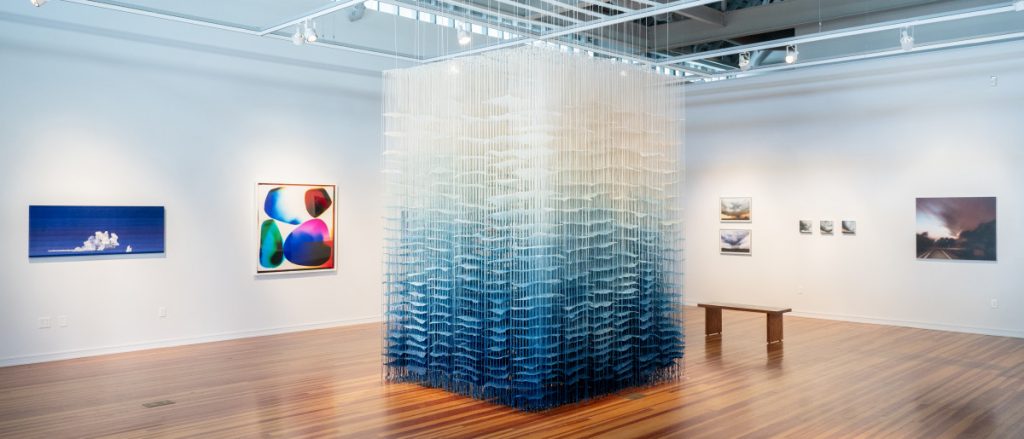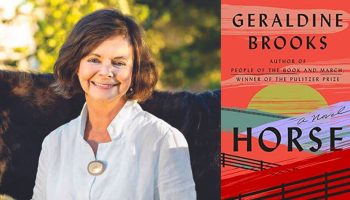
Julia Weber
Staff writer
Strohl Art Center’s first-floor exhibition isn’t the most traditional landscape collection.
“Sense of Place” is a collection of pieces spanning different mediums that explore landscape as a broader idea compared to a specific image.
On view at Strohl through this weekend, “Sense of Place” is curated by Assistant Director of Chautauqua Visual Arts Galleries Erika Diamond.
The idea of quintessential landscape paintings can bring to mind a number of art movements: From Chinese shan shui or the Hudson River School and the Romanticism movement, to the impressionist and post-impressionist idealized and abstracted works of artists like Claude Monet and Vincent Van Gogh.
This exhibition, though, toes a line between traditional landscape paintings and conceptual art. Many of the pieces are heavily abstracted, questioning what the boundaries of landscape are, and how we relate to the landscapes that surround us.
“Sense of Place” challenges viewers to consider their relation to landscape and to question what a landscape can be. The exhibition combines mediums like photography, painting, video and textile. At the center of the exhibition is Mika Obayashi’s “Gospel of Three Dimensions.” The massive installation of dyed paper strung from the ceiling by cord evokes a feeling of awe from viewers through its massive scale and detail.
Obayashi said she hopes people find beauty through the exhibition.
“I hope they might bring their own ideas of gospel and spirituality and how an aesthetic experience can become transcendental,” she said. “I also hope people might think about their position to and within nature.”
Nearby is Obayashi’s “Repeating the Truth,” equally as intricate, but smaller in size.
Obayashi cites nature as a main source of inspiration, but said she is particularly inspired by intangible aspects of nature like balance, liminality and ephemerality.
Situated throughout the gallery space are heavily abstracted, pigmented pieces created by Liz Nielsen. She uses a distinctive process, often creating works without a camera which she describes on her website as “light paintings.” These paintings are made by manipulating light-sensitive paper in a darkroom.
“My photograms reflect a fascination with light as a tangible, yet ethereal phenomenon,” according to Neilsen in a description of her piece “Friends” on her website. “My work is about harnessing its incredible power to shape space and eclipse/collapse time, merging a multiplicity of realities into a finite yet dynamic form.”
Contrasting with the abstract, vibrant pieces of soothing skies and seascapes, Samantha Fields’ blurred landscape paintings depict dark and stormy skies, leaving viewers with an impression that the end is near. Her pieces are out of focus, evoking uncertainty about what’s to come.
Fields writes in the description of her work that it explores severe weather imagery, which is often widely disseminated in the media, as it relates to her own lived experiences.
“The slow apocalypse of climate change is with us every day; from heat waves, wildfires, grid failures and floods, to storms rolling across the roads we travel with our beloveds. I’m interested in the daily, ongoing signs that are screaming at us, like the cursed Cassandra, that the end is surely near,” she said in the description. “But this world has a skin that looks the same as it ever was, and even shared moments of alarm recede into the bread and circuses that fill our days and our feeds, and we march one step closer to our assured end.”
For Lien Truong and Hong An Truong, “Sense of Place” is a vessel for investigating the intersection of nature and politics. “The Sky is Not Sacred” is a two-part piece comprising a video component and a painting. The piece critically examines the relationship between the environment, politics and how climate has been weaponized.
“Together, image and text concede in admiration and awe, to the sky’s stature as a sublime, horrifying space. ‘The Sky Is Not Sacred’suggests the tension between the aesthetic and the political, and asserts the way in which Western ideologies have violently impacted the Vietnamese landscape, and more broadly, how they have shaped our cultural and emotional relationship to landscape as an imaginary space,” according to the description.
Also adorning the walls are a number of skies and seascapes containing deep, rich blue hues. From afar, they’re seemingly straightforward and simple. Up close, though, the extent of detail in the pieces starts to emerge.
The landscapes, created by Maria Fernanda Barrero, are entirely embroidered and reveal complex designs within the pieces. Barrero uses these pieces as a way to explore the ways in which we are bound to nature.
Part of what Barrero wants people to understand through her art is the importance of caring for our environment. She compared our earth and ecosystem to a home.
“How will you damage your house, how will you keep your bedroom filthy, or your kitchen filthy if you are eating from it, or if you are living from it? We wouldn’t do it,” Barrero said.
Tending to and caring for the environment is a common thread throughout the diverse collection of artworks in the exhibition. “Sense of Place” challenges viewers to not only appreciate the landscapes surrounding them, but to go a step beyond and consider their connections to the environment and their responsibility to their surroundings.
Barrero said this exhibit may evoke a sense of soothing and connectedness that allows for more open-minded discussion.
“When you start talking more about it, then it seems that all of us, like human beings, tend to agree that we need more of that,” Barrero said.




